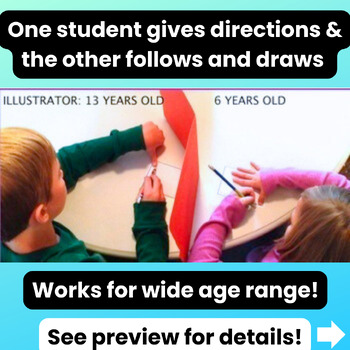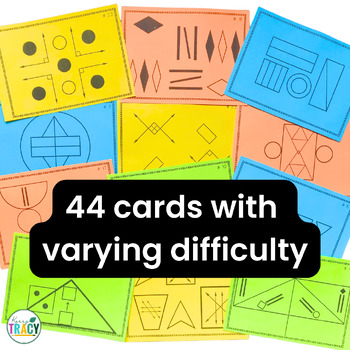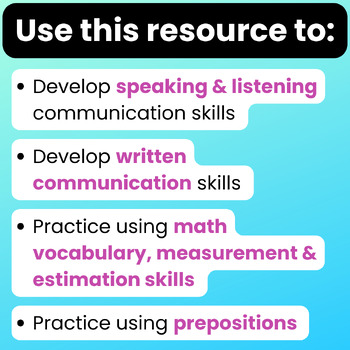Speaking & Listening Skills | Oral Communication Activity Task Cards
- PDF
What educators are saying
Also included in
- Looking for quick and easy STEM activities to implement in 30 minutes or less? Wouldn't it feel amazing when you head back to school to have a stockpile of ready-to-go, simple STEM activities to use as warm-ups / bell ringers, centers, sub plans, choice boards, early finishers or any time at all?ThePrice $39.00Original Price $154.92Save $115.92
Description
This activity is a great to tool to practice oral and written communication skills as well as reinforce math vocabulary, estimation, and measurement skills. It's perfect for reinforcing following directions, sub day plans, center activities and more.
Here's how it works:
- Pair students up.
- Student A gets an image card to describe to Student B.
- Student B draws what Student A describes.
- Students compare the images to see how well they communicated.
In this set, students will describe relative size and position of various shapes, lines, and angles [triangle (right, acute, obtuse, scalene, equilateral, isosceles), square, rectangle, parallelogram, hexagon, pentagon, octagon, circle, oval, parallel lines, intersecting lines, perpendicular lines, etc.] Though students don't strictly need to use this vocabulary to succeed, it certainly helps!
There are MANY ways to use these 44 image cards to practice communication. Watch this video for ideas on how to use the cards!
This resource includes:
- 44 director cards of varying complexity
- Blank set of cards for students to illustrate based on directions and/or to create their own images.
- Blank set of cards for students to illustrate based on directions and/or to create their own images.
- Teacher Tips
- How to use the task cards
- Several ideas included for whole-class, small groups/partners, and groups
- Includes ways to increase difficulty (though you won’t likely need to until the students have a good amount of experience!)
- One sample script to introduce the activity
- How to use the task cards
- Center direction cards for students
Timing Note: It was difficult for me to choose a teaching duration for these cards because there are so many different ways to use them. For example (probably the most common scenario): If each day you choose to use two cards so each student gets a chance to direct and to draw, it would take about 15 minutes a day. That said, each class is different so you'll need to try it out to know for sure how long it will take for your students.
Please don’t hesitate to reach out with questions.






